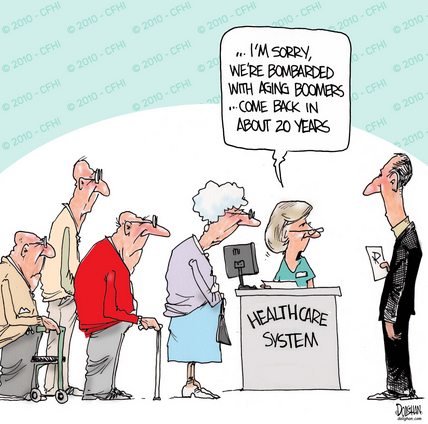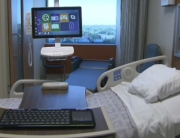Baby boomers have been called the rabbit inside the snake; because their numbers are so large they’re like the ball that blips out of the population statistics. As that ball continues to roll and more baby boomers become seniors, Canada will experience a pressure on its health care system like never before.

Canada’s aging population is one of the key megatrends in global health care and experts are predicting it will have a huge impact on our health care system. Seniors are the fastest-growing segment of our population. According to the Canadian Medical Association’s 2014 annual report, seniors now represent 15 per cent of the population, compared to eight per cent in 1971. By the time all baby boomers have reached 65, that number may be as high as 25 per cent.
Life expectancy in Canada has grown from 75 years in 1979 to 81 years in 2009. In 2011, there were 5,825 centenarians in Canada, an increase of 25.7 per cent since 2006, according to Statistics Canada. Globe and Mail columnist and author Jeffrey Simpson wrote in his award-winning book Chronic Condition, Canada’s health care system needs to be dragged into the 21st Century, the over 65 age group consumed about 44 per cent of all health care spending in 2008, despite representing only 13.7 per cent of the population.
With the health problems that accompany aging, health care services will become even more heavily concentrated on seniors. Not only will we see major increases in the number of people suffering from chronic diseases and disabilities, but the demand for better patient-centered care will increase.
That’s where technology will play a critical role, not only in terms of helping to manage health care costs but in its ability to provide patient-centered care. Expect to see more of the following as technology is leveraged to decrease costs and improve services for aging patients:
• Digital literacy – more online training and education available across multiple devices include smart phones, televisions and other devices;
• Healthcare gamification – engaging digital methods to improve mental acuity or help family members learn better methods of care;
• Home diagnostics – more methods for early detection, especially of such diseases as Alzheimer’s and dementia which currently impact 750,000 Canadians. If dementia can be diagnosed earlier, treatment therapies can potentially help to stave off the advance of the disease. According to the Alzheimer Society of Canada, the earlier people begin taking medication, the more effective the treatment can be.
• Smartwatches or other wearable devices to track heart rate, blood pressure or other important baselines;
• Tele-health services – where community care workers or specialists can be available to meet with patients over internet methods.
The internet is already playing a significant role in helping medical professionals and patients or their families connect. The following survey by Cisco show that trust in telehealth services is increasing.


Canada’s aging population may be inevitable but it doesn’t have to hit us like a “grey tsunami.” Instead, it can effectively be managed through the use of technology, especially now with so many devices at our fingertips. The Canadian medical system is already benefiting from a growing community of technology providers who are focussed on developing better solutions to help alleviate pressures on healthcare. And for medical professionals everywhere, that news is great medicine.
This blog will explore the many facets of healthcare in Canada and the benefits that Panacea™ patient and clinical engagement solution brings to the industry. Stay tuned for further blogs on Canadian Healthcare and how Panacea™ transformed one patient’s hospital stay along with studies on patient satisfaction.







